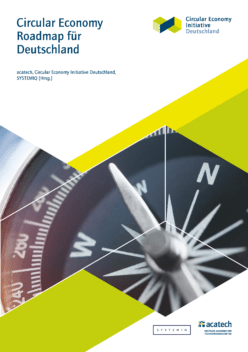The circular economy aims to optimise our cycles of energy and material use. But how do we drive that change in society? Today, Circular Economy Initiative Deutschland publishes its roadmap for Germany, offering recommendations on the next steps for science, policy and the economy.
Today’s production and consumption models tend to be linear: we extract, produce, consume… and dispose. It’s damaging our climate and polluting our environment – and the problems don’t end there. The Circular Economy involves a fundamental change. It aims to optimise our cycles of energy and material use. But how do we drive that change in society?
The Circular Economy Initiative Deutschland (CEID) has examined the change processes required for a successful transformation. Today, it publishes its Circular Economy Roadmap for Germany, offering recommendations on the next steps for science, policy and the economy.
Michael Meister, Parliamentary State Secretary to the Federal Minister of Education and Research, has already welcomed the roadmap and its recommendations: “We need a resource-efficient circular economy so that we can bequeath future generations a world in which they too can lead healthy and prosperous lives. The Circular Economy Roadmap für Deutschland sets out how science, industry, government and civil society can work together to achieve this goal.”
Key findings
“If we are really consistent in how we apply those circular economy principles, we find this can address a number of other closely intertwined problems at the same time”, explains Susanne Kadner, the Managing Director of CEID at acatech, Germany’s National Academy of Science and Engineering. “I’m thinking particularly about climate change and the EU’s Green Deal target of being climate neutral by 2050, but also about resource use, biodiversity and global health.”
For Kadner, one of the key functions of the circular economy is to decouple economic growth from resource use. It’s a huge shift. Historically, our growth and prosperity have always depended on us using up the Earth’s resources. “This separation enables us to improve living standards and ensure a just prosperity, without pushing economic activity beyond our planetary boundaries.” According to analysis from the CEID, “using the levers of a circular economy – including longer product life, more intensive product use, and more recycling – by 2050 we could be using 68% less primary raw materials than we did in 2018.”
The Circular Economy Roadmap for Germany describes a gradual transition to a Circular Economy by 2030. Making that happen will require a reframing of financial incentives, explains Martin Stuchtey, the Managing Partner of SYSTEMIQ, one of the CEID’s co-founders and collaborators. “That includes taxation, subsidies and pricing of environmental damage, as a way of supporting business decisions that are optimised for resource use and for the climate. In other words: we need to penalise or reward economic actors on the basis of their resource use and environmental impacts.” Such measures would not only help protect biodiversity and mitigate climate change, but would also support the development of innovative digital business models. “One example is the shift of taxation towards carbon pricing and resource use – although we need more scientific analysis on the effects of such measures.”
The report calls on Germany’s politicians to drive these ideas forward at national and EU level; the need for policy engagement is one that Thomas Weber, Chair of CEID, fully endorses. “Germany needs – and the sooner the better – an integrated and comprehensive Circular Economy Strategy with concrete targets on waste reduction, recycling, overall resource use and more”, while stressing that will also require businesses to actively support an explicit environmental focus in industrial policy. “We have put together specific options for companies to adopt new business models as providers of ‘circular services’, instead of products. We have also shown how a circular economy approach to plastics can address the waste problem. Another example involves circular battery management, where resource scarcity could actually give rise to a whole new service industry. It is now up to us all to implement these proposals together – it’s a genuinely exciting prospect!”


